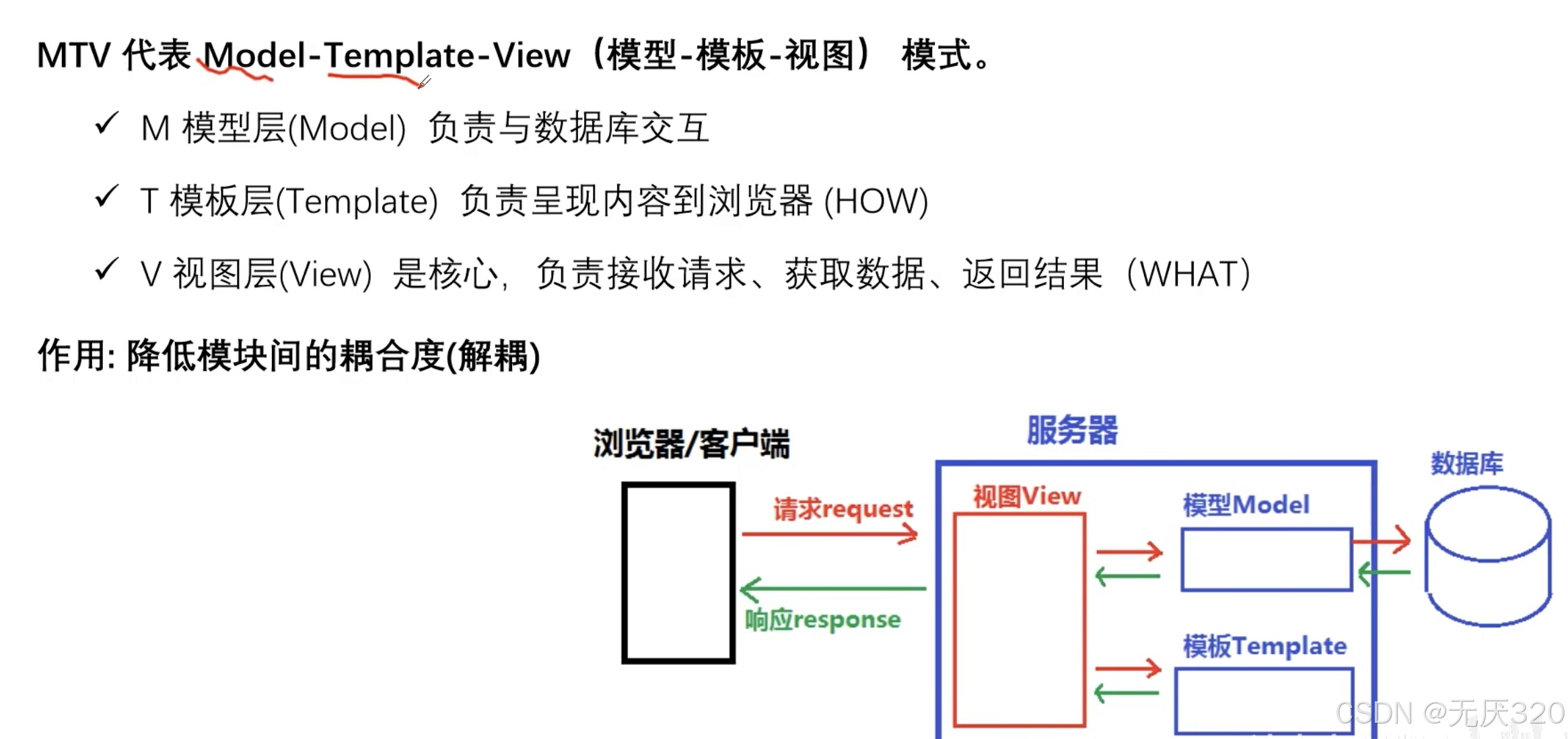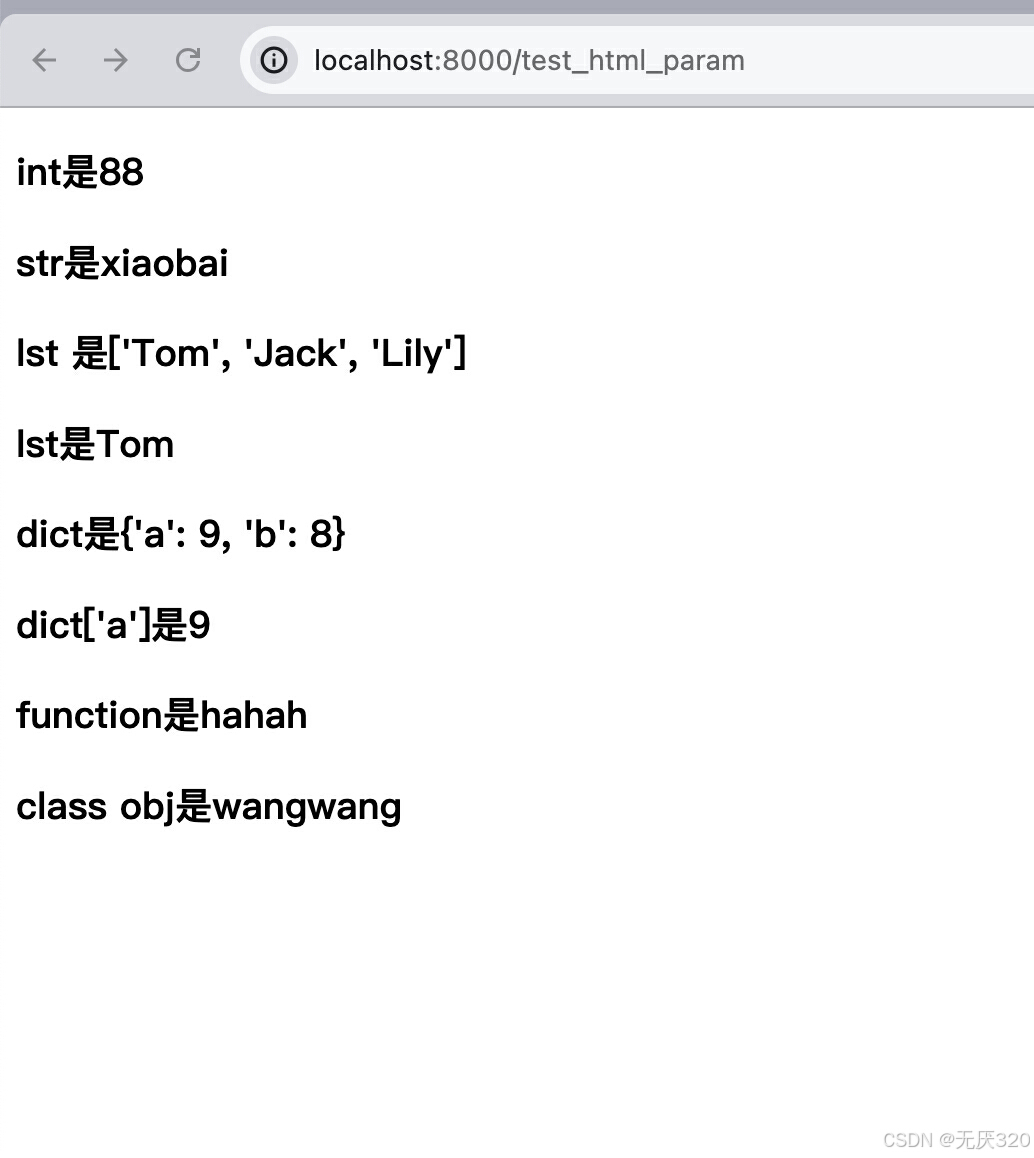Django的设计模式及模板层
传统的MVC(例如java)
 Django的MTV
Django的MTV

模板层:

 模板加载:
模板加载:


代码:
views.py
def test_html(request):#方案一# from django.template import loader# 1. 使用loader加载模板# t = loader.get_template('test_html.html')# # 将t转换成html字符串# html = t.render()# return HttpResponse(html)# 方案二from django.shortcuts import renderreturn render(request, 'test_html.html')urls.py
path('test_html', views.test_html)
templates.py
<!DOCTYPE html>
<html lang="en">
<head><meta charset="UTF-8"><title>Title</title>
</head>
<body>
<h1>Hello World</h1>
</body>
</html>视图层与模板层之间的交互:
 代码:
代码:
views.py
def test_html(request):#方案一# from django.template import loader# 1. 使用loader加载模板# t = loader.get_template('test_html.html')# # 将t转换成html字符串# html = t.render()# return HttpResponse(html)# 方案二from django.shortcuts import renderdic = {'name': 'zhangsan','age': 18,'sex': '男','hobby': ['吃饭', '睡觉', '打豆豆'],'person': {'name': 'lisi', 'age': 20},}return render(request, 'test_html.html', dic)templates
<!DOCTYPE html>
<html lang="en">
<head><meta charset="UTF-8"><title>Title</title>
</head>
<body>
<h1>{{name}}今年{{ age }}性别{{ sex }}爱好{{ hobby }}</h1>
</body>
</html>urls.py
path('test_html', views.test_html)
结果:
模板的变量和标签:


代码:
urls.py
path('test_html_param', views.test_html_param)
views.py
def test_html_param(request):dic = {}dic['int'] = 88dic['str'] = 'xiaobai'dic['lst'] = ['Tom', 'Jack', 'Lily']dic['dict'] = {'a': 9, 'b': 8}dic['func'] = say_hidic['classobj'] = Dog()return render(request, 'test_html_param.html', dic)def say_hi():return 'hahah'class Dog(object):def say(self):return 'wangwang'templates
<!DOCTYPE html>
<html lang="en">
<head><meta charset="UTF-8"><title>Title</title>
</head>
<body>
<h3>int是{{int }}</h3>
<h3>str是{{str }}</h3>
<h3>lst 是{{lst}}</h3>
<h3>lst是{{lst.0 }}</h3>
<h3>dict是{{dict}}</h3>
<h3>dict['a']是{{dict.a}}</h3>
<h3>function是{{func}}</h3>
<h3>class obj是{{classobj.say}}</h3>
</body>
</html>结果:

模板标签:


 代码:
代码:
urls.py
path('test_if_for', views.test_if_for)
views.py
def test_if_for(request):dic = {}dic['x'] = 5return render(request, 'test_if_for.html', dic)templates
<!DOCTYPE html>
<html lang="en">
<head><meta charset="UTF-8"><title>测试if和for</title>
</head>
<body>
{% if x >= 4 %}
输入的值大于等于4
{% else %}
输入的值为小于4
{% endif %}
</body>
</html>注意:在标签中使用变量时,直接使用变量名即可,不需要加双大括号
for标签:


urls:
path('test_if_for', views.test_if_for)
views.py:
def test_if_for(request):dic = {}dic['x'] = 5dic['ls'] = ['a', 'b', 'c']return render(request, 'test_if_for.html', dic)templates:
<!DOCTYPE html>
<html lang="en">
<head><meta charset="UTF-8"><title>测试if和for</title>
</head>
<body>
<p>
{% if x >= 4 %}
输入的值大于等于4
{% else %}
输入的值为小于4
{% endif %}
<br>
{% for name in ls %}{% if forloop.first %}########{% endif %}{{ forloop.counter0 }}{{ name }}</p>{% if forloop.last %}########{% endif %}
{% empty %}
没有值
{% endfor %}
</body>
</html>
